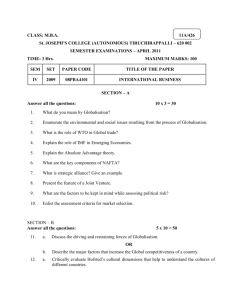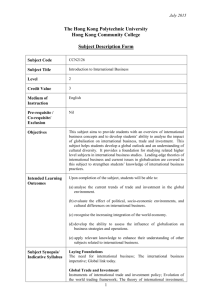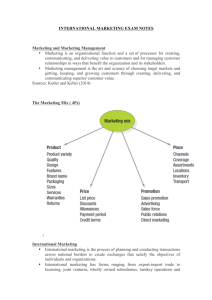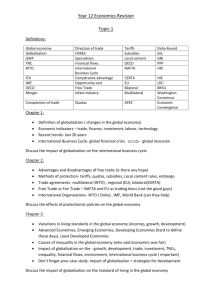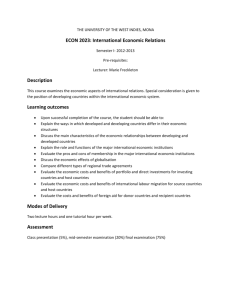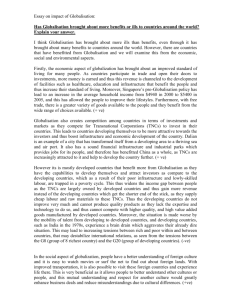Globalization_and_Social_Policy2013
advertisement
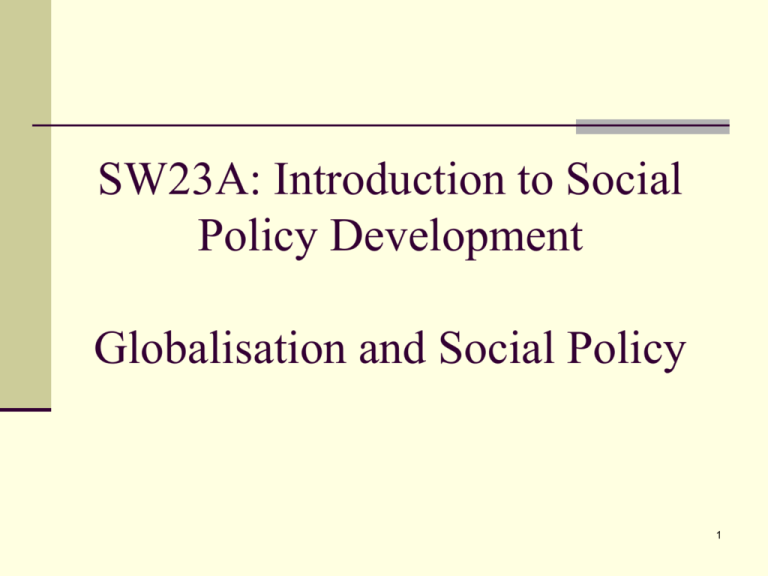
SW23A: Introduction to Social Policy Development Globalisation and Social Policy 1 Objectives Explaining the current developments in Caribbean social policy Delimiting the paradigmatic shifts Analysing the impact of globalisation and community participation in social policy Examining the needs of vulnerable groups including the disabled and children 2 Paradigms Traditional (Prevailing) Latent / Emergent – arising from economic pressures due to the introduction of Structural Adjustment and Stabilization programs of 1980s Perhaps a mixture of the best features of the two might achieve greatest efficiency & efficacy 3 Paradigms Important Dimensions to be Considered When Comparing both Models Institutional Forms Decision-making process Financing Objective Criterion re priorities for expanding system Beneficiary population Approach Indicator used 4 Institutional Form Traditional (Prevailing) State monopoly of all social services Finance Design Implementation Control Unified functions performed by state Emergent Multiple sub-sectors (Welfare Pluralism involves many actors) State Private (commercial) Philanthropic (NGOs) Informal (family) Separate functions e.g. commercial involvement in public insurance and pension schemes. Govt. sets regulatory framework and rules for investment but allows firms to manage public funds. 5 Institutional Form Traditional (Prevailing) Emergent All decisions taken Decentralization – Advantages Government/Federal -leads to tailoring of solutions for particular needs, -greater attention paid to rural areas, Advantages – Govt. takes -encourages local participation, advantage of economies of scale, allows for greater choice in ensures standard quality, especially solutions, when local agencies lack Disadvantages capacity/skills. -local regions may lack capacity and Disadvantages may favor could cause quality variations in dominant groups in capitals/main social services provided in each area towns and ignore rural areas - one size does not fit all, local - poor areas may not generate differences/needs cannot be enough tax revenue to support all services required. addressed. 6 --limited public participation possible Centralization at Central level. – Centralization Centralization can lead to inefficient resource allocation, favouring of dominant/well-organised and vocal groups located in capital or main towns, inhibited participation by citizens; cost implications for service users (members of the public travel time etc.) and for service providers (HSOs must transport goods to various locations if bulk buying is used). Susceptible to corruption. 7 Advantages of Decentralization • Advantages of Decentralization greater social consensus – local participation benefits greater control of bureaucracy smaller scales could mean greater opportunity for cost-benefit analysis paves the way for widespread development of system-wide capabilities. 8 Disadvantages of Decentralisation • Disadvantages of Decentralisation local autonomy in providing social services could lead to some unacceptable variations in the standards of services delivered. increased research (offset by increased relevance of policy and programme), monitoring and evaluation costs. 9 Decision-making process Traditional (Prevailing) Emergent Bureaucratic By projects presented by endusers Macro-strategies “Innovative capacity “The State knows what to do” exists throughout society Users have no say or choice in the type of service provided by State and every effort should be made to take advantage of it” (Franco, 1996) - Resources allocated administratively - Resources allocated competitively, tendering used - Allocation of funds proposed by users e.g. (Jamaica Social Investment Fund, CHASE Fund) 10 Financing – Source of Resources Traditional (Prevailing) Emergent The State covers all costs – from Co-financing – private sector fiscal sources which must meet invlovement e.g NCB paying exam multiple, growing demands fees, school subsidies; tax rebates received in exchange for help. “No Charge = No good”: – view that anything provided free tends not to be fully appreciated by recipients Recovery of costs: “He who can pay should pay” – cost sharing in schools and hospitals Risk: marginalization of the poor,11 as they may be unable to pay user fees Financing – Resource Allocation Traditional (Prevailing) Emergent Subsidization of supply, e.g. Subsidization of demand – e.g. subsidies on food items like rice, oil giving vouchers to the poor to buy chicken, or using price controls basic food items or pay for education or PATH which pays school fees for - Absence of competition, all firms poor directly to the school once the family selects school must charge the same price Creation of quasi-markets -Those who do not need the benefit - Allows competition and freedom to (middle and upper classes) receive choose it. - Users must have enough information to select among service providers 12 Objective – Universality? Traditional (Prevailing) Emergent Universal supply Universal satisfaction of people’s needs - High cost, Low impact especially among those who need it most. E.g. Govt provides free primary education to all but there is low attendance in rural areas. Also now free secondary tuition – no impact on attendance. Principle of Equity “Unequal treatment for those who are economically and socially unequal” – affirmative action / positive discrimination supply for - Homogeneous supply to all Homogenous situations only favours those who are best- heterogenous informed and best organized . E.g. perpetuates the original differences NHF heavily used by middle class. 13 Criterion re Priorities for expanding system Traditional (Prevailing) Gradual expansion of social protection as more resources become available -Top down, those who need it most often last to receive help (Franco refers to this as Segmented access) Emergent The neediest first Instrument: targeting the poorest Targeting allows improvement in programme design as the more accurate the identification of the problem and nature of the beneficiaries, the easier to design specific interventions. Targeting “Less social expenditure = less also ensure more efficient use of scarce resources and increases equity” e.g. NIS not given to those who impact of the programme by did not contribute regularly over concentrating resources on the 14 highest-risk groups. their working life Criterion re Priorities for expanding system Traditional (Prevailing) Emergent - Attention given to what the – identifying potential sources of funding want. beneficiaries as precisely as possible & designing programme to ensure major per capita impact on selected group 15 Beneficiary Population Traditional (Prevailing) The middle class Organised groups who have the capacity to pressure the state Emergent The poor – often do not benefit as much as the middle classes from government spending. Reality is that their situation is dire 16 Approach Traditional (Prevailing) Centered on the means – e.g. expanding the coverage of services provided - Increasing Social infrastructure and current Expenditure e.g. building more schools Emergent Centered on the ends Impact: Quality of service - How much did beneficiaries actually receive when compared to original objectives? - Has poverty been reduced? By how much? Evaluation of achievement of programme goals 17 is critical Indicator Used Traditional (Prevailing) Emergent Size of Public social expenditure – Cost-impact ratio –were resources efficiently used, was there max Expenditure may be high, but not impact for minimum cost? efficiently used, (mainly salaries) also programmes poorly What were the measurable implemented increases in HC, and at what cost? 18 Implications • Under the traditional paradigm, there is prevailing view that more resources available means more persons were helped or that the system lowered the number of poor persons. • Necessary to disaggregate social expenditure and analyse the real beneficiaries. • Cost-impact ratio is recommended in Emergent paradigm - optimization of resource use. 19 GLOBALISATION 20 What is Globalisation? Globalisation can be viewed as the increased international economic interdependence and interconnectedness of world markets and societies facilitated by rapid advances in communication and transportation technologies. 21 What is Globalisation? Often referred to as creation of the “global village” Not a new phenomenon, globalisation has occurred in waves. The first wave1800s to 1930s (colonial period). The volume of the flow of goods and capital in the 1800s was only exceeded by the wave of globalisation of the late 1970s 22 Distinctive Features of the Latest Wave of Globalisation (mid 1970s --) Change from nationally organised economic activity/growth to globally organised economic activity e.g. World car vs. German car. (See article on Red Stripe on OURVLE) The rise of huge transnational corporations (TNCs) some of which are larger than individual states. TNCs which dominate markets can exert great pressure on governments . 23 Distinctive Features of the Latest Wave of Globalisation (mid 1970s --) Transnational corporations (TNCs) also called multinational companies. A transnational, or multinational, corporation has its headquarters in one country and operates wholly or partially owned subsidiaries in one or more other countries. 24 Distinctive Features of the Latest Wave of Globalisation (mid 1970s --) The subsidiaries report to the central headquarters. The growth in the number and size of transnational companies since the 1950s has generated controversy because of their economic and political power and the mobility and complexity of their operations. 25 Distinctive Features of the Latest Wave of Globalisation (mid 1970s --) Some critics argue that transnational corporations exhibit no loyalty to the countries in which they are incorporated but act solely in their own best interests. 26 Distinctive Features of the Latest Wave of Globalisation (mid 1970s --) Growth of regional trading blocs, NAFTA (1994), EU (1993), CSM (2006), Mercusor (1991), Andean Pact (1969) Underlying philosophy – Economic Neo-liberalism, open markets and free trade. (Ferguson, Lavalette et al, 2002). Asian tigers held up as examples of export-driven success stories, but McMichael, (2004) points out that these countries, Singapore, Taiwan, Hong Kong and South Korea began as centrally planned not liberalised economies. 27 Distinctive Features of the Latest Wave of Globalisation (mid 1970s --) Growth of regional trading blocs, Nafta, EU, CSM, Mercusor, Andean Pact Mercosur was established in 1991 and encompasses Argentina, Brazil, Paraguay and Uruguay. Venezuela was accepted as a member in 2006 and is currently in the process of integrating into Mercosur. 28 Distinctive Features of the Latest Wave of Globalisation (mid 1970s --) Andean Pact – The Andean Community is the regional integration in the Andean countries consisting of Bolivia, Colombia, Ecuador, and Peru, along with some associate and observer countries also located in Latin America that was started in 1969 with the signature of the Cartagena Agreement creating the Andean Group with the objective of creating a customs union and a common market. The 29 Distinctive Features of the Latest Wave of Globalisation (mid 1970s --) In 1979 the Andean Council of Foreign Ministers was established at the Andean Tribunal and the Andean Parliament in Bogotá. In 1985 the Andean Parliament agreed to the establishment of the Andean University Simon Bolivar located in Sucre, former capital Bolivia. In 1993 it established the free trade area; 1995 the Andean countries adopted a Common External Tariff. 30 Distinctive Features of the Latest Wave of Globalisation (mid 1970s --) Structural adjustment programmes (SAPs) opened economies in the South and accelerated the process of globalisation for those countries. Underlying belief of globalisation is that increased trade will benefit all nations - “a rising tide lifts all boats”. Some economies were not able to withstand foreign competition associated with open markets, e.g. local manufacturing and agriculture in Jamaica. Free trade, is not necessarily fair trade. 31 Features of Globalisation Spread of US cultural influence and value systems via internet and cable TV. Increased culture of individualism (each man for himself approach) seen in Caribbean nations, undermines collectivism and community spirit. 32 Main Actors GATT – General Agreement on Tariffs and Trade Created in 1947 after WWII. Aim was to reduce tariff barriers, quotas and trade subsidies World Trade Organisation established Jan 1995product of the GATT Uruguay Round. WTO is the major institution in process of globalization. WTO Trade rules are enforceable, it can punish member states for violation. WTO has power to regulate all aspects of trade agriculture, investment, intellectual property, services Many groups worldwide oppose the WTO. 33 Main Actors WTO rules based on theory of comparative advantage - Specialize in production of goods which can be produced efficiently and import other goods. Small island developing states (SIDS) lack economies of scale, and adequate subsidy protection to produce most goods more efficiently than other countries. 34 Main Events Affecting Caribbean NAFTA – 1994 Led to demise of Jamaica’s garment sector Factories relocated to Mexico Job losses for low-skilled women free-zone CARICOM – CSM Winners and losers, Jamaica is a net importer from CARICOM, imports far exceed exports Trinidad emerged as dominant economic power, largely owing to its subsidized energy. OECS has formed economic union with T’dad, planning to move to political union. 35 Main Events Affecting Caribbean WTO 1997 ruling against EU LOME Banana regime – led by Bill Clinton on behalf of Dole and Chiquita. Preferential tariff treatment by EU deemed in violation of WTO rules Major economic fall-out in the Windward islands, Grenada, St. Lucia, St. Vincent and Grenadines, Dominica Increase in poverty in Windward islands Economic collapse of Dominica led to IMF agreement Jamaica ended its banana exports to EU in 2008 partially due to lower earnings and repeated hurricane damage. Major unemployment fallout in banana 36 parishes. Main Events Affecting Caribbean WTO 2004 ruling against EU LOME sugar protocol – led by Brazil, Thailand and Australia EU forced to phase out preferential arrangement with ACP sugar producers which included dutyfree access for agreed quantities of sugar and a guaranteed price approximating that applied for European beet farmers Agreement phased out between 2005-2009 37 Main Events Affecting Caribbean Trinidad and St. Kitts ended sugar production Jamaica cut sugar production, made some workers redundant, divested factories B’dos producing more high-end speciality sugars for hotel/tourist market. Moving to diversify into ethanol production 38 Main Events Affecting Caribbean Economic Partnership Agreement (EPA) – Oct 2008 with EU Based on reciprocity, not the one-way preferential access of LOME Some items excluded and delayed phase-in for others Wide-ranging, includes trade in services, government procurement, investment rules which were not part of LOME May influence negotiation with Canada and US who intend to negotiate FTAs with Jamaica. 39 Globalisation Opportunities Increased availability of a wider array of technologies, goods and services. Increased competition leading to lower costs in some sectors, e.g. cellular competition between Lime, Digicel and Claro 40 Globalisation Opportunities Increases access to investment capital, but most Foreign Direct Investment (FDI) has gone to developed, not developing nations. Many Third World countries lack the capacity to absorb FDI, i,e. good physical infrastructure, highly skilled workforce etc. – Note Intel’s Costa Rican example. 41 Globalisation Opportunities Third World nations are more dependent on FDI to generate growth than First World nations with FDI accounting for a larger share of their GDP (15% vs 9% for First World countries (Hann, 2007). Globalisation has increased economic growth of some countries, but not at rates faster than in previous decades (Hann, 2007) 42 Challenges/Concerns “Race to the bottom” –resulting from intense competition among states to attract FDI from TNCs. Countries offer lower wages for labour, lower corporate tax rates, (in Jamaica gov’t offers 100% tax holidays to some investors, e.g. those who build hotels). Also sees less enforcement of occupational health and safety standards, environmental protections also union busting or suppression, e.g. collapse of buildings and injury/death of workers at Bahia Principe hotel site in St. Ann due to lack of adequate safety measures. Also hotel site was deemed an environmentally protected area but building 43 permit was still issued by the GOJ. Challenges/Concerns Race to the bottom - Use of Child labour especially in Asian countries Global Capital flows liberalised but labour has seen increased controls/ immigration laws. Movement of capital causes labour dislocations E.g. NAFTA led to closure of factories and relocation of jobs to Mexico, Jamaican workers could not relocate to keep those jobs. 44 Challenges/Concerns Has increased international inequality between and within nations, as some sectors collapse while others emerge, especially in Africa, Caribbean and Latin America (McMichael, 2004, Hann, 2007) Increase in poverty among marginalised groups, e.g. ethnic minorities (Hann, 2007) and the low-skilled 45 Challenges/Concerns Reduction of government tax revenue e.g. from lower import tariffs/duties. These duties are often not used to protect competing local products, e.g. car import duty, but to generate revenue to fund social services. TNCs often avoid paying corporate tax locally by locating global headquarters in tax havens e.g. Amazon and Apple. 46 Challenges/Concerns Trade liberalisation pressures from WTO/ IMF/WB led to increased agricultural imports and collapse of local agriculture in the South - increased rural poverty. New global movement focused on food sovereignty has emerged to revitalise local farming in Southern countries (McMichael, 2004). In Ja this is seen in the “grow what we eat and eat what we grow campaign”. 47 Challenges/Concerns - Labour Increased long-term unemployment due to relocation of jobs to cheaper manufacturing sites or closure of industries like banana and free-zones Job-less and job-loss growth – economic growth often associated with job losses as global competition forces firms to increase use of labour-replacing technology to increase “efficiency”. NB: Zuboff’s Catch-22 48 Challenges/Concerns - Labour Increased migration of skilled workers, (brain drain in Jamaica) and illegal migration of unskilled workers. Huge exploitation of undocumented workers worldwide. Not only of Caribbean, African and Latino workers in US/EU but also Haitians exploited in Dom Republic and Jamaica. Many often work in near slavery conditions. 49 Challenges/Concerns - Labour Informalisation and Casualisation of Labour –firms move to temporary or part-time contracts with few or no benefits, limited union protection, (McMichael, 2004) Concepts of workplace being a life-time employer with full-time work, pensions and social and legal protection, perks and benefits is fast becoming extinct. 50 Challenges/Concerns These labour market changes will require provision of more social protection and social security, e.g. safety nets, health insurance, and pensions by states. However loss of tax revenue may limit what governments can offer. Residualization of some aspects of welfare often results e.g. cost sharing. Recent expansion in universal social services in Caribbean have been done to address increases in inequality and build human capital e.g. free health care in Jamaica, free tertiary education in T’dad 51 Challenges/Concerns Increase in global criminal networks facilitated by technology advances, undermines state control. Globalisation also said to cause loss of local cultural identities and distinctiveness Ritzer’s McDonaldization thesis. McDonaldization has been successful because of four basic dimensions. McDonaldization offers consumers Efficiency (2) Calculability (3) Predictability and (4) Control. 52 Challenges/Concerns Deskilling - A work force with the minimum abilities possible to complete simple focused tasks. This means that they can be quickly and cheaply trained and are easily replaceable. Workers on an assembly line that are hired and trained to perform a single highly rationalized task. Although this may be a very efficient method of operating a business, an irrationality that is spawned 53 Challenges/Concerns TRIPS (Trade Related Intellectual Property Rights) – trading regulation of the WTO limits the production of affordable generic drugs to combat diseases, e.g. generic HIV drugs needed by poor countries TRIPS criticized for not recognising traditional knowledge developed by small societies in the development of patented pharmaceuticals E.g. Neem Tree in India; patents registered by US and Japanese companies. 54 Challenges/Concerns GATS - General Agreement on Trade in services. Jamaica is a signatory to that WTO agreement which requires liberalisation of trade in services including health and education markets. Clause requires that education subsidies given to local Universities should also be extended to foreign colleges. If implemented this could result in a withdrawal of subsidies to local colleges incl UWI and higher tuition fees 55 Globalisation of Social Policy Globalisation of Social Policy – Occurs when global governance structures like the UN, World Bank, IMF and WTO exert greater influence on states policy making direction (Yeates, 2001) Proliferation of international treaties since 1970s – Third World states urged to ratify by UN e,g. Convention on Rights of Child, UN Millennium Development Goals – (students should be aware of MDGs) 56 Globalisation of Social Policy “Social policy contributes to governance and renewed legitimation of the State, but its importance today lies above all in its contribution to the formation of human capital, which is indispensable for the medium-term competitiveness of our countries.” (Franco in CEPAL Review 58, April 1996) 57 Globalisation of Social Policy Benefits International treaties have brought many important social issues to local attention e.g. gender discrimination, human rights abuses, child issues, disability concerns (Yeates, 2001) Sharing of policy initiatives globally leads to increased standardisation in areas such as human rights, public health systems and child protection. 58 Globalisation of Social Policy Sharing of “best practices” builds capacity in social service delivery in the South. Drawbacks Bias in policy directives towards Western approaches often overshadows local expertise, or are not culturally relevant. Imposition of global social policy frameworks like MDGs reduces national sovereignty and constrains social policy making. 59 Globalisation of Social Policy Funding agencies like UNICEF, UNDP tie grant/loan funds to Millennium Development Goals which may not be the priority areas for a government. E.g. primary education is already universal in Jamaica, secondary education is not. Neo-liberal approach institutionalised 60 Political Impact Globalisation led to a consolidation of the ideology of neo-liberalism and of AngloAmerican capitalism as the dominant economic system – this is being rejected in aftermath of current recession, as US and EU businesses turn to their states for bailouts, also many South American countries have been embracing socialist policies e.g. Venezuela High youth unemployment leads to alienation in among youth –feel helpless in the face of global market systems leads to increase in anti-social behaviours, terror groups (McMichael, 2004) 61 Thinking Point: Which House of Government? – Robert Campbell, Chairman of Tasmania Together Progress Board Partnerships – Govt/TNCs/Community Control and Rules Inside directs outside Consultation and Customer Service Strategic planning begins, but in back rooms Connections and Collaborations – outside starts directing inside Gov’t. not sole provider of solutions Strategic planning with community Gov’t. as facilitator 62
